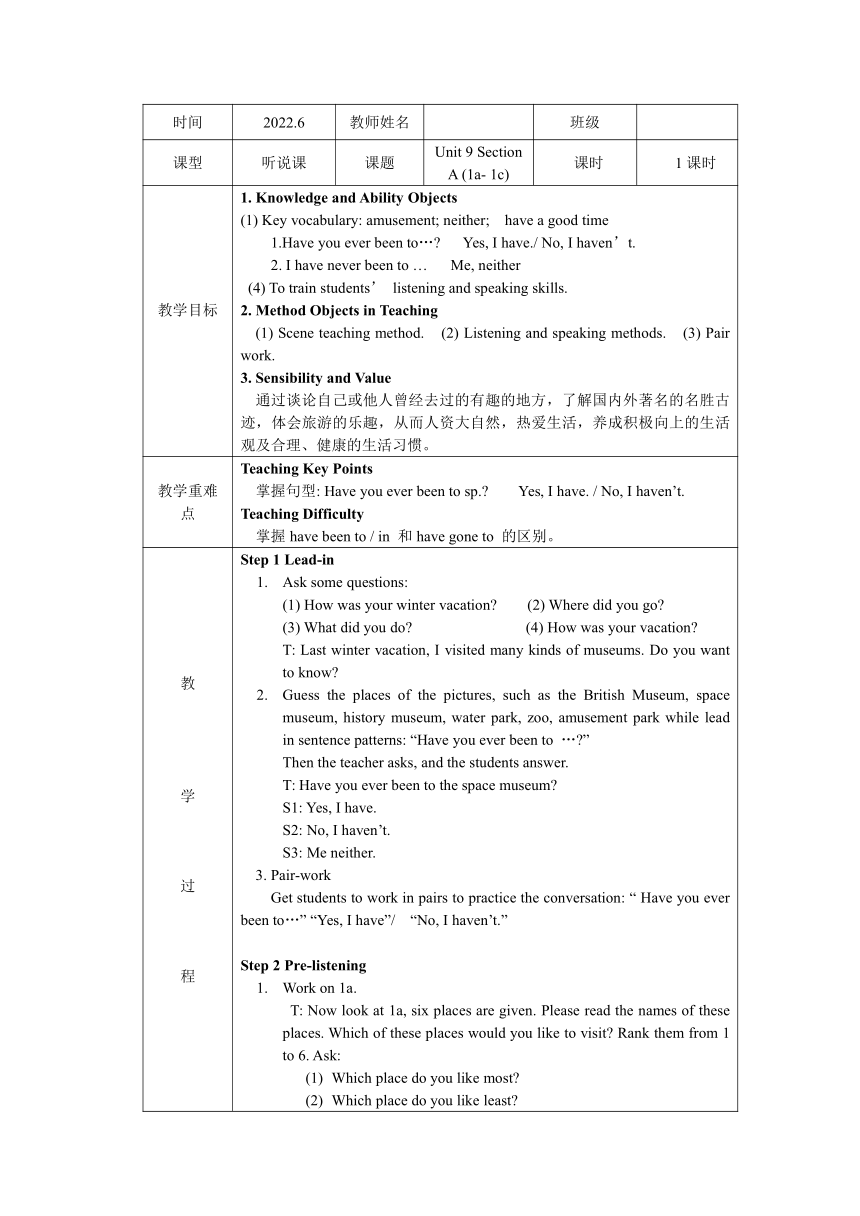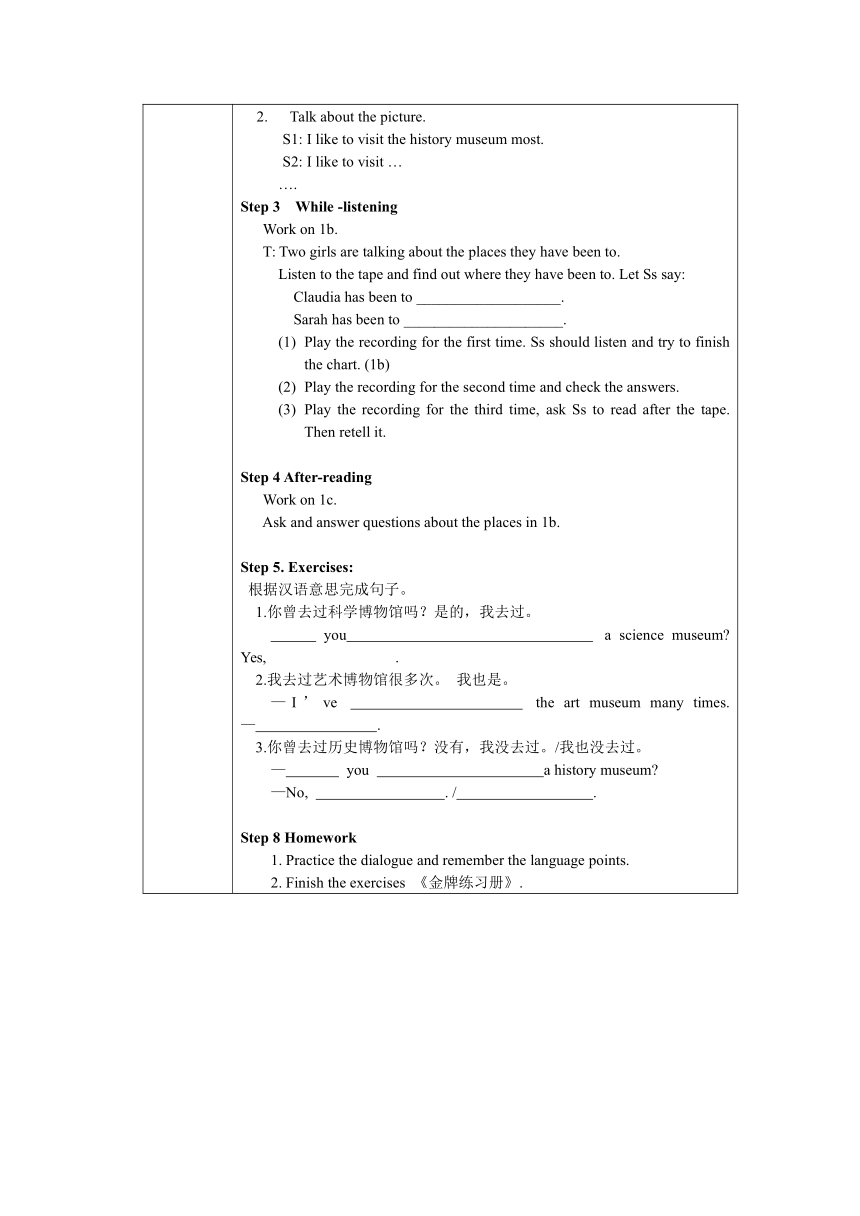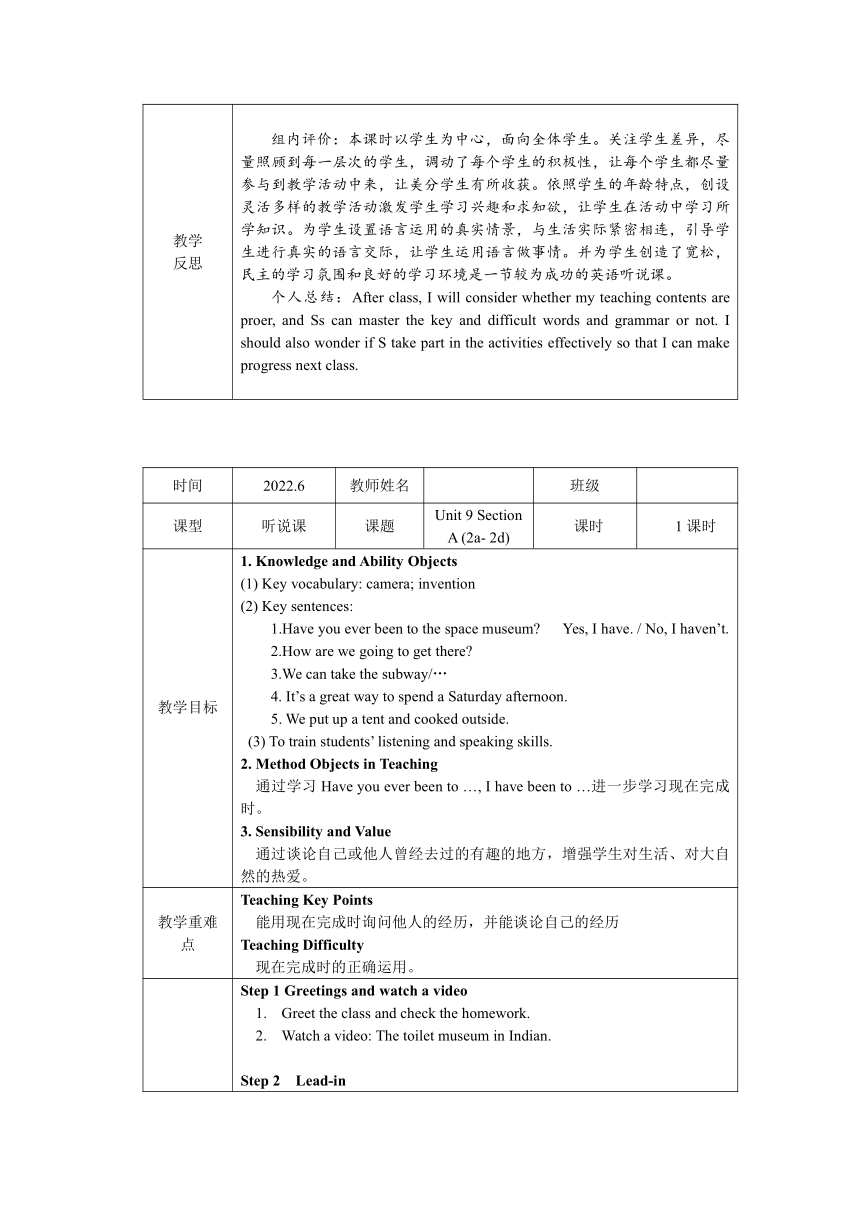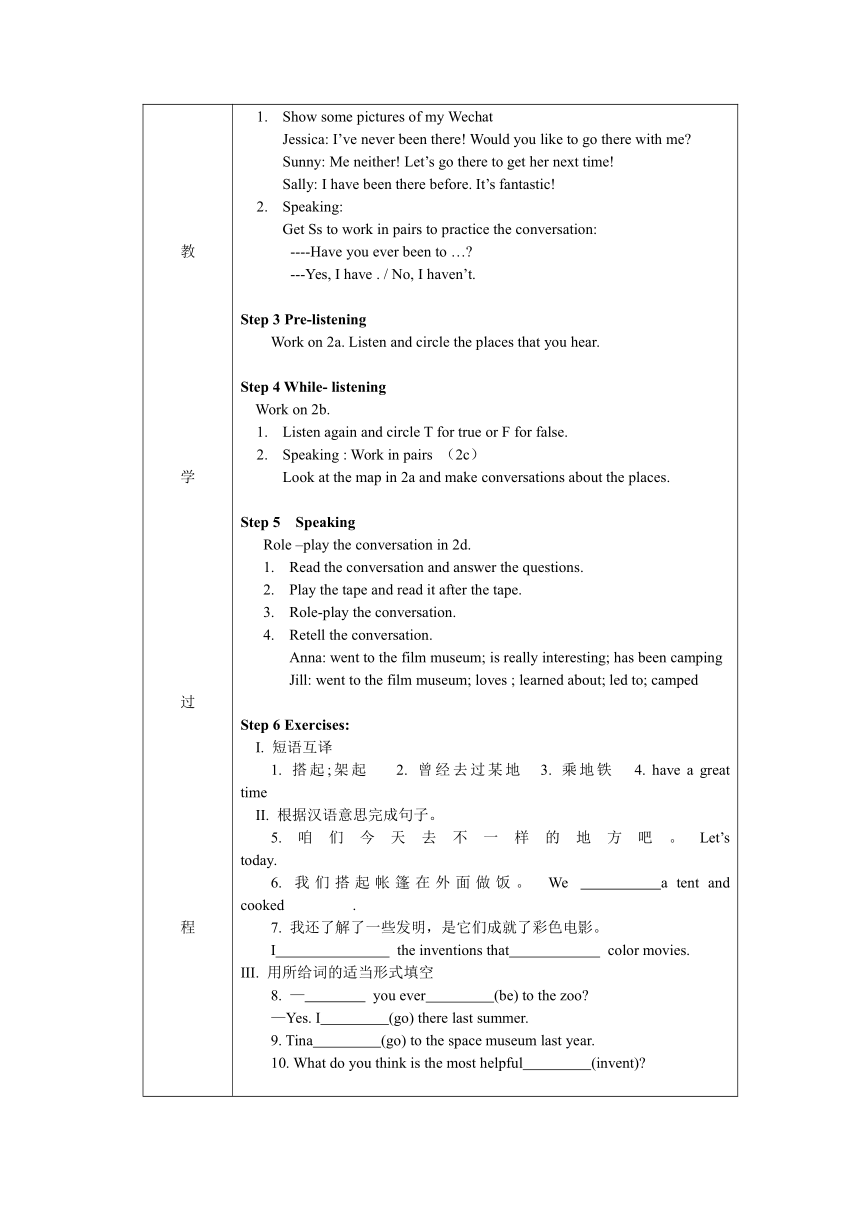2021-2022学年人教版英语八年级下册Unit 9 Have you ever been to a museum?- SectionA(共4课时)教案
文档属性
| 名称 | 2021-2022学年人教版英语八年级下册Unit 9 Have you ever been to a museum?- SectionA(共4课时)教案 |

|
|
| 格式 | zip | ||
| 文件大小 | 29.1KB | ||
| 资源类型 | 教案 | ||
| 版本资源 | 人教新目标(Go for it)版 | ||
| 科目 | 英语 | ||
| 更新时间 | 2022-03-02 18:17:31 | ||
图片预览




文档简介
时间 2022.6 教师姓名 班级
课型 听说课 课题 Unit 9 Section A (1a- 1c) 课时 1课时
教学目标 1. Knowledge and Ability Objects (1) Key vocabulary: amusement; neither; have a good time 1.Have you ever been to… Yes, I have./ No, I haven’t. 2. I have never been to … Me, neither (4) To train students’ listening and speaking skills. 2. Method Objects in Teaching (1) Scene teaching method. (2) Listening and speaking methods. (3) Pair work. 3. Sensibility and Value 通过谈论自己或他人曾经去过的有趣的地方,了解国内外著名的名胜古迹,体会旅游的乐趣,从而人资大自然,热爱生活,养成积极向上的生活观及合理、健康的生活习惯。
教学重难点 Teaching Key Points 掌握句型: Have you ever been to sp. Yes, I have. / No, I haven’t. Teaching Difficulty 掌握have been to / in 和have gone to 的区别。
教 学 过 程 Step 1 Lead-in Ask some questions: (1) How was your winter vacation (2) Where did you go (3) What did you do (4) How was your vacation T: Last winter vacation, I visited many kinds of museums. Do you want to know Guess the places of the pictures, such as the British Museum, space museum, history museum, water park, zoo, amusement park while lead in sentence patterns: “Have you ever been to … ” Then the teacher asks, and the students answer. T: Have you ever been to the space museum S1: Yes, I have. S2: No, I haven’t. S3: Me neither. 3. Pair-work Get students to work in pairs to practice the conversation: “ Have you ever been to…” “Yes, I have”/ “No, I haven’t.” Step 2 Pre-listening Work on 1a. T: Now look at 1a, six places are given. Please read the names of these places. Which of these places would you like to visit Rank them from 1 to 6. Ask: Which place do you like most Which place do you like least Talk about the picture. S1: I like to visit the history museum most. S2: I like to visit … …. Step 3 While -listening Work on 1b. T: Two girls are talking about the places they have been to. Listen to the tape and find out where they have been to. Let Ss say: Claudia has been to ___________________. Sarah has been to _____________________. Play the recording for the first time. Ss should listen and try to finish the chart. (1b) Play the recording for the second time and check the answers. Play the recording for the third time, ask Ss to read after the tape. Then retell it. Step 4 After-reading Work on 1c. Ask and answer questions about the places in 1b. Step 5. Exercises: 根据汉语意思完成句子。 1.你曾去过科学博物馆吗?是的,我去过。 you a science museum Yes, . 2.我去过艺术博物馆很多次。 我也是。 —I’ve the art museum many times. — . 3.你曾去过历史博物馆吗?没有,我没去过。/我也没去过。 — you a history museum —No, . / . Step 8 Homework 1. Practice the dialogue and remember the language points. 2. Finish the exercises 《金牌练习册》.
教学 反思 组内评价:本课时以学生为中心,面向全体学生。关注学生差异,尽量照顾到每一层次的学生,调动了每个学生的积极性,让每个学生都尽量参与到教学活动中来,让美分学生有所收获。依照学生的年龄特点,创设灵活多样的教学活动激发学生学习兴趣和求知欲,让学生在活动中学习所学知识。为学生设置语言运用的真实情景,与生活实际紧密相连,引导学生进行真实的语言交际,让学生运用语言做事情。并为学生创造了宽松,民主的学习氛围和良好的学习环境是一节较为成功的英语听说课。 个人总结:After class, I will consider whether my teaching contents are proer, and Ss can master the key and difficult words and grammar or not. I should also wonder if S take part in the activities effectively so that I can make progress next class.
时间 2022.6 教师姓名 班级
课型 听说课 课题 Unit 9 Section A (2a- 2d) 课时 1课时
教学目标 1. Knowledge and Ability Objects (1) Key vocabulary: camera; invention (2) Key sentences: 1.Have you ever been to the space museum Yes, I have. / No, I haven’t. 2.How are we going to get there 3.We can take the subway/… 4. It’s a great way to spend a Saturday afternoon. 5. We put up a tent and cooked outside. (3) To train students’ listening and speaking skills. 2. Method Objects in Teaching 通过学习Have you ever been to …, I have been to …进一步学习现在完成时。 3. Sensibility and Value 通过谈论自己或他人曾经去过的有趣的地方,增强学生对生活、对大自然的热爱。
教学重难点 Teaching Key Points 能用现在完成时询问他人的经历,并能谈论自己的经历 Teaching Difficulty 现在完成时的正确运用。
教 学 过 程 Step 1 Greetings and watch a video Greet the class and check the homework. Watch a video: The toilet museum in Indian. Step 2 Lead-in Show some pictures of my Wechat Jessica: I’ve never been there! Would you like to go there with me Sunny: Me neither! Let’s go there to get her next time! Sally: I have been there before. It’s fantastic! Speaking: Get Ss to work in pairs to practice the conversation: ----Have you ever been to … ---Yes, I have . / No, I haven’t. Step 3 Pre-listening Work on 2a. Listen and circle the places that you hear. Step 4 While- listening Work on 2b. Listen again and circle T for true or F for false. Speaking : Work in pairs (2c) Look at the map in 2a and make conversations about the places. Step 5 Speaking Role –play the conversation in 2d. Read the conversation and answer the questions. Play the tape and read it after the tape. Role-play the conversation. Retell the conversation. Anna: went to the film museum; is really interesting; has been camping Jill: went to the film museum; loves ; learned about; led to; camped Step 6 Exercises: I. 短语互译 1. 搭起;架起 2. 曾经去过某地 3. 乘地铁 4. have a great time II. 根据汉语意思完成句子。 5.咱们今天去不一样的地方吧。Let’s today. 6. 我们搭起帐篷在外面做饭。 We a tent and cooked . 7. 我还了解了一些发明,是它们成就了彩色电影。 I the inventions that color movies. III. 用所给词的适当形式填空 8. — you ever (be) to the zoo —Yes. I (go) there last summer. 9. Tina (go) to the space museum last year. 10. What do you think is the most helpful (invent) Step 7 Homework 1. Listen to the tape (2a/ 2b) three times. 2. Read 2d and retell the conversation.
教学 反思 本课时教学反复运用句型“Have you ever been to… ” “I’ve never been to …”来激发学生学习本单元的单词的兴趣。并以现在完成时态为中心,通过听说读写的训练,来加深对现在完成时态的理解,明白英汉两种语言在结构及表达方式的一些异同点,从而提高他们运用所学语言的综合能力。
时间 2022.6 教师姓名 班级
课型 阅读课 课题 Unit 9 Section A 3a—3c 课时 1课时
教学目标 I. 语言知识目标: 1. Key vocabulary: unbelievable, progress, rapid, unusual, toilet, encourage, social, peaceful, performance, perfect, itself, collect 2. Key sentences: 1) The most interesting museum I’ve been to is theAmerican Computer Museum. 2) It’s unbelievable that technology has progressed in such a rapid way! 3) I wonder how much more computer will be able to do in the future 4) It also encourages governments and social groups to think bout ways to improve toilets in the future. 5) Watching them prepare the tea with the beautiful tea sets is just as enjoyable as drinking the tea itself 3. To train students’ reading ability 4. To get students know some knowledge about many kinds of museums. II. 学习策略: 通过核心句型的学习,学生能钢架牢固地掌握谈论过去经历的句型。 能运用Skimming 获取文章大意,理解语句间的关联; 能运用Scanning捕捉到具体信息,理解细节,猜测生词在句中的含义。 III. 情感态度价值观目标: 能拓宽视野,了解不同国家的博物馆文化;通过小组活动,增强合作意识,培养与他人沟通的能力。
教学重难点 I. Teaching Key Points 1. 了解三段不同的国际文化,对语篇的细节理解; 2. 能在阅读中提炼并熟悉现在完成时的用法。 II. Teaching Difficulties 一般过去时和现在完成时的用法区别; 阅读技巧及能力的培养。
教 学 过 程 Step 1. Revision: Have a dictation Write some new words. Step 2 Before reading 1) Let Ss watch the three pictures, talk about them. Brainstorm: think of the kinds of museums that you can name. 2) Watch a video. A video about the International Museum of Toilets. And then talk about the video. 3) Work on 3a. Ask Ss to talk about every picture. Answer the questions. Step 3. While reading Fast reading Ask Ss to read the passage quickly and answer the question: Which three museums do you think about Careful reading Read Para. 1 to answer the two questions. Read Para. 2 to answer the two questions. Read Para. 3 to answer the following questions. Read the passage again and answer the questions. (3b) Read the passage and find out the difficult points. Discuss them in groups. have/ has been to ; have/ has gone to; in such a rapid way; encourage sb. to do sth.; think about; watch sb. do sth.; watch sb. doing sth. Step 4 After reading Share the whole story with students according to the chart. Retell the story according to the charts. Ask Ss to finish 3c by themselves, then check the answers. Step 5 Exercise 根据汉语意思完成句子 1. 观看茶艺准备和喝茶本身一样令人享受。 the tea preparation is as as drinking the tea . 2. 我终于认识到我祖父为什么喜欢饮茶以及收藏茶具了。 I’ve why my grandpa loves drinking tea and tea sets. 3. 它还鼓励政府和社会团体想办法改善未来的厕所。 It also governments and social groups about ways to improve toilets in the future. 4. 令人难以置信的是, 科学技术已取得了如此迅速的发展。 It’s that technology in way. Step 6 Homework 1. Remember the words and expressions. 2. Finish the exercises 《金牌练习册》
教学 反思 本课时利用看图片进行头脑风暴以及小视频导入话题,培养学生感知事物的能力,在以后的学习过程中,接触有关背景信息,就会知道即将要谈论的主题;通过快速阅读,给学生一些简单的练习,训练学生快速捕捉关键信息的能力,也可以让学生潜移默化的学习到skimming和scanning两种阅读技巧,并且练习了这两种阅读策略。其效果很好。
时间 2022.6 教师姓名 班级
课型 语法课 课题 Unit 9 Section A Grammar Focus—4c 课时 1课时
教学目标 知识目标:1. 学习并掌握词汇:a couple of; German; theme; ride; province 复习并巩固现在时的结构及用法 能力目标:1. 现在完成时与一般过去时的用法区别; 2. 能够准确使用多种时态谈论自己的经历; 情感态度价值观: 通过本课的学习,了解中国的博物馆历史,同时拥有乐观向上的精神。
教学重难点 1. Teaching Key Points 1. The present perfect tense. 2. How to use the present perfect tense. 2. Teaching Difficulties To understand and use the present perfect tense.
教 学 过 程 Step 1 Enjoy a video Play a video and ask Ss to watch it carefully. Try to understand the meaning of the video. Step2 Free talk Show a picture of different museum. Ask Ss to say : Have you ever been to a museum What kind of museum do you like Why Step 3 Grammar Focus Ask students to read the sentences of Grammar focus aloud. ever / never Step 4 Learn the Present Perfect Tense 1. 构成: have(助动词) + p.p has(第三人称单数助动词) + p.p have not 常缩略为haven’t has not 常缩略为hasn’t 2. 用法: (1)表示过去发生或已经完成的动作对现在造成的影响或结果。 (2)某些动词的现在完成时可表示过去某一时间开始并一直持续到现在(包括现在)的动作或者状态,可以和表示延续的时间状语连用。表示持续动作或状态的是延续性动词。 ever 意为“曾经”,用于疑问句或否定句中,放在助动词与过去分词之间。 3. have been to & have gone to区别 have / has been (to) 表示“曾经到过某地”,说话时此人不在那里,已经回来。侧重指经历。 have / has gone (to) 表示某人“已经去某地了”,说话时此人可能在路上或已到那里,反正不在这里。 一般过去时与现在完成时的区别 Step 5 Exercises 1. Finish 4a on textbook. Put the correct form of the verbs in the blanks. 2. Finish 4b on textbook. Fill in the blanks with the correct forms of the verbs in brackets. 3. Finish 4c on textbook. Answer the survey questions and then ask your partner. Step 6 Homework Remember the grammar in this unit. Finish the exercise《金牌练习册》.
教学 反思 本课时主要是总结本单元学习的新语法——现在完成时,从结构、用法进行总结归纳,帮助学生弄清现在完成时和一般过去时的用法区别,这是初中阶段很难理解的时态。设计大量练习,并创设情景,帮助学生理解,起到很好的作用,其效果较好,但还需加强练习。
课型 听说课 课题 Unit 9 Section A (1a- 1c) 课时 1课时
教学目标 1. Knowledge and Ability Objects (1) Key vocabulary: amusement; neither; have a good time 1.Have you ever been to… Yes, I have./ No, I haven’t. 2. I have never been to … Me, neither (4) To train students’ listening and speaking skills. 2. Method Objects in Teaching (1) Scene teaching method. (2) Listening and speaking methods. (3) Pair work. 3. Sensibility and Value 通过谈论自己或他人曾经去过的有趣的地方,了解国内外著名的名胜古迹,体会旅游的乐趣,从而人资大自然,热爱生活,养成积极向上的生活观及合理、健康的生活习惯。
教学重难点 Teaching Key Points 掌握句型: Have you ever been to sp. Yes, I have. / No, I haven’t. Teaching Difficulty 掌握have been to / in 和have gone to 的区别。
教 学 过 程 Step 1 Lead-in Ask some questions: (1) How was your winter vacation (2) Where did you go (3) What did you do (4) How was your vacation T: Last winter vacation, I visited many kinds of museums. Do you want to know Guess the places of the pictures, such as the British Museum, space museum, history museum, water park, zoo, amusement park while lead in sentence patterns: “Have you ever been to … ” Then the teacher asks, and the students answer. T: Have you ever been to the space museum S1: Yes, I have. S2: No, I haven’t. S3: Me neither. 3. Pair-work Get students to work in pairs to practice the conversation: “ Have you ever been to…” “Yes, I have”/ “No, I haven’t.” Step 2 Pre-listening Work on 1a. T: Now look at 1a, six places are given. Please read the names of these places. Which of these places would you like to visit Rank them from 1 to 6. Ask: Which place do you like most Which place do you like least Talk about the picture. S1: I like to visit the history museum most. S2: I like to visit … …. Step 3 While -listening Work on 1b. T: Two girls are talking about the places they have been to. Listen to the tape and find out where they have been to. Let Ss say: Claudia has been to ___________________. Sarah has been to _____________________. Play the recording for the first time. Ss should listen and try to finish the chart. (1b) Play the recording for the second time and check the answers. Play the recording for the third time, ask Ss to read after the tape. Then retell it. Step 4 After-reading Work on 1c. Ask and answer questions about the places in 1b. Step 5. Exercises: 根据汉语意思完成句子。 1.你曾去过科学博物馆吗?是的,我去过。 you a science museum Yes, . 2.我去过艺术博物馆很多次。 我也是。 —I’ve the art museum many times. — . 3.你曾去过历史博物馆吗?没有,我没去过。/我也没去过。 — you a history museum —No, . / . Step 8 Homework 1. Practice the dialogue and remember the language points. 2. Finish the exercises 《金牌练习册》.
教学 反思 组内评价:本课时以学生为中心,面向全体学生。关注学生差异,尽量照顾到每一层次的学生,调动了每个学生的积极性,让每个学生都尽量参与到教学活动中来,让美分学生有所收获。依照学生的年龄特点,创设灵活多样的教学活动激发学生学习兴趣和求知欲,让学生在活动中学习所学知识。为学生设置语言运用的真实情景,与生活实际紧密相连,引导学生进行真实的语言交际,让学生运用语言做事情。并为学生创造了宽松,民主的学习氛围和良好的学习环境是一节较为成功的英语听说课。 个人总结:After class, I will consider whether my teaching contents are proer, and Ss can master the key and difficult words and grammar or not. I should also wonder if S take part in the activities effectively so that I can make progress next class.
时间 2022.6 教师姓名 班级
课型 听说课 课题 Unit 9 Section A (2a- 2d) 课时 1课时
教学目标 1. Knowledge and Ability Objects (1) Key vocabulary: camera; invention (2) Key sentences: 1.Have you ever been to the space museum Yes, I have. / No, I haven’t. 2.How are we going to get there 3.We can take the subway/… 4. It’s a great way to spend a Saturday afternoon. 5. We put up a tent and cooked outside. (3) To train students’ listening and speaking skills. 2. Method Objects in Teaching 通过学习Have you ever been to …, I have been to …进一步学习现在完成时。 3. Sensibility and Value 通过谈论自己或他人曾经去过的有趣的地方,增强学生对生活、对大自然的热爱。
教学重难点 Teaching Key Points 能用现在完成时询问他人的经历,并能谈论自己的经历 Teaching Difficulty 现在完成时的正确运用。
教 学 过 程 Step 1 Greetings and watch a video Greet the class and check the homework. Watch a video: The toilet museum in Indian. Step 2 Lead-in Show some pictures of my Wechat Jessica: I’ve never been there! Would you like to go there with me Sunny: Me neither! Let’s go there to get her next time! Sally: I have been there before. It’s fantastic! Speaking: Get Ss to work in pairs to practice the conversation: ----Have you ever been to … ---Yes, I have . / No, I haven’t. Step 3 Pre-listening Work on 2a. Listen and circle the places that you hear. Step 4 While- listening Work on 2b. Listen again and circle T for true or F for false. Speaking : Work in pairs (2c) Look at the map in 2a and make conversations about the places. Step 5 Speaking Role –play the conversation in 2d. Read the conversation and answer the questions. Play the tape and read it after the tape. Role-play the conversation. Retell the conversation. Anna: went to the film museum; is really interesting; has been camping Jill: went to the film museum; loves ; learned about; led to; camped Step 6 Exercises: I. 短语互译 1. 搭起;架起 2. 曾经去过某地 3. 乘地铁 4. have a great time II. 根据汉语意思完成句子。 5.咱们今天去不一样的地方吧。Let’s today. 6. 我们搭起帐篷在外面做饭。 We a tent and cooked . 7. 我还了解了一些发明,是它们成就了彩色电影。 I the inventions that color movies. III. 用所给词的适当形式填空 8. — you ever (be) to the zoo —Yes. I (go) there last summer. 9. Tina (go) to the space museum last year. 10. What do you think is the most helpful (invent) Step 7 Homework 1. Listen to the tape (2a/ 2b) three times. 2. Read 2d and retell the conversation.
教学 反思 本课时教学反复运用句型“Have you ever been to… ” “I’ve never been to …”来激发学生学习本单元的单词的兴趣。并以现在完成时态为中心,通过听说读写的训练,来加深对现在完成时态的理解,明白英汉两种语言在结构及表达方式的一些异同点,从而提高他们运用所学语言的综合能力。
时间 2022.6 教师姓名 班级
课型 阅读课 课题 Unit 9 Section A 3a—3c 课时 1课时
教学目标 I. 语言知识目标: 1. Key vocabulary: unbelievable, progress, rapid, unusual, toilet, encourage, social, peaceful, performance, perfect, itself, collect 2. Key sentences: 1) The most interesting museum I’ve been to is theAmerican Computer Museum. 2) It’s unbelievable that technology has progressed in such a rapid way! 3) I wonder how much more computer will be able to do in the future 4) It also encourages governments and social groups to think bout ways to improve toilets in the future. 5) Watching them prepare the tea with the beautiful tea sets is just as enjoyable as drinking the tea itself 3. To train students’ reading ability 4. To get students know some knowledge about many kinds of museums. II. 学习策略: 通过核心句型的学习,学生能钢架牢固地掌握谈论过去经历的句型。 能运用Skimming 获取文章大意,理解语句间的关联; 能运用Scanning捕捉到具体信息,理解细节,猜测生词在句中的含义。 III. 情感态度价值观目标: 能拓宽视野,了解不同国家的博物馆文化;通过小组活动,增强合作意识,培养与他人沟通的能力。
教学重难点 I. Teaching Key Points 1. 了解三段不同的国际文化,对语篇的细节理解; 2. 能在阅读中提炼并熟悉现在完成时的用法。 II. Teaching Difficulties 一般过去时和现在完成时的用法区别; 阅读技巧及能力的培养。
教 学 过 程 Step 1. Revision: Have a dictation Write some new words. Step 2 Before reading 1) Let Ss watch the three pictures, talk about them. Brainstorm: think of the kinds of museums that you can name. 2) Watch a video. A video about the International Museum of Toilets. And then talk about the video. 3) Work on 3a. Ask Ss to talk about every picture. Answer the questions. Step 3. While reading Fast reading Ask Ss to read the passage quickly and answer the question: Which three museums do you think about Careful reading Read Para. 1 to answer the two questions. Read Para. 2 to answer the two questions. Read Para. 3 to answer the following questions. Read the passage again and answer the questions. (3b) Read the passage and find out the difficult points. Discuss them in groups. have/ has been to ; have/ has gone to; in such a rapid way; encourage sb. to do sth.; think about; watch sb. do sth.; watch sb. doing sth. Step 4 After reading Share the whole story with students according to the chart. Retell the story according to the charts. Ask Ss to finish 3c by themselves, then check the answers. Step 5 Exercise 根据汉语意思完成句子 1. 观看茶艺准备和喝茶本身一样令人享受。 the tea preparation is as as drinking the tea . 2. 我终于认识到我祖父为什么喜欢饮茶以及收藏茶具了。 I’ve why my grandpa loves drinking tea and tea sets. 3. 它还鼓励政府和社会团体想办法改善未来的厕所。 It also governments and social groups about ways to improve toilets in the future. 4. 令人难以置信的是, 科学技术已取得了如此迅速的发展。 It’s that technology in way. Step 6 Homework 1. Remember the words and expressions. 2. Finish the exercises 《金牌练习册》
教学 反思 本课时利用看图片进行头脑风暴以及小视频导入话题,培养学生感知事物的能力,在以后的学习过程中,接触有关背景信息,就会知道即将要谈论的主题;通过快速阅读,给学生一些简单的练习,训练学生快速捕捉关键信息的能力,也可以让学生潜移默化的学习到skimming和scanning两种阅读技巧,并且练习了这两种阅读策略。其效果很好。
时间 2022.6 教师姓名 班级
课型 语法课 课题 Unit 9 Section A Grammar Focus—4c 课时 1课时
教学目标 知识目标:1. 学习并掌握词汇:a couple of; German; theme; ride; province 复习并巩固现在时的结构及用法 能力目标:1. 现在完成时与一般过去时的用法区别; 2. 能够准确使用多种时态谈论自己的经历; 情感态度价值观: 通过本课的学习,了解中国的博物馆历史,同时拥有乐观向上的精神。
教学重难点 1. Teaching Key Points 1. The present perfect tense. 2. How to use the present perfect tense. 2. Teaching Difficulties To understand and use the present perfect tense.
教 学 过 程 Step 1 Enjoy a video Play a video and ask Ss to watch it carefully. Try to understand the meaning of the video. Step2 Free talk Show a picture of different museum. Ask Ss to say : Have you ever been to a museum What kind of museum do you like Why Step 3 Grammar Focus Ask students to read the sentences of Grammar focus aloud. ever / never Step 4 Learn the Present Perfect Tense 1. 构成: have(助动词) + p.p has(第三人称单数助动词) + p.p have not 常缩略为haven’t has not 常缩略为hasn’t 2. 用法: (1)表示过去发生或已经完成的动作对现在造成的影响或结果。 (2)某些动词的现在完成时可表示过去某一时间开始并一直持续到现在(包括现在)的动作或者状态,可以和表示延续的时间状语连用。表示持续动作或状态的是延续性动词。 ever 意为“曾经”,用于疑问句或否定句中,放在助动词与过去分词之间。 3. have been to & have gone to区别 have / has been (to) 表示“曾经到过某地”,说话时此人不在那里,已经回来。侧重指经历。 have / has gone (to) 表示某人“已经去某地了”,说话时此人可能在路上或已到那里,反正不在这里。 一般过去时与现在完成时的区别 Step 5 Exercises 1. Finish 4a on textbook. Put the correct form of the verbs in the blanks. 2. Finish 4b on textbook. Fill in the blanks with the correct forms of the verbs in brackets. 3. Finish 4c on textbook. Answer the survey questions and then ask your partner. Step 6 Homework Remember the grammar in this unit. Finish the exercise《金牌练习册》.
教学 反思 本课时主要是总结本单元学习的新语法——现在完成时,从结构、用法进行总结归纳,帮助学生弄清现在完成时和一般过去时的用法区别,这是初中阶段很难理解的时态。设计大量练习,并创设情景,帮助学生理解,起到很好的作用,其效果较好,但还需加强练习。
同课章节目录
- Unit 1 What's the matter?
- Section A
- Section B
- Unit 2 I'll help to clean up the city parks.
- Section A
- Section B
- Unit 3 Could you please clean your room?
- Section A
- Section B
- Unit 4 Why don't you talk to your parents?
- Section A
- Section B
- Unit 5 What were you doing when the rainstorm came
- Section A
- Section B
- Review of Units 1-5
- Unit 6 An old man tried to move the mountains.
- Section A
- Section B
- Unit 7 What's the highest mountain in the world?
- Section A
- Section B
- Unit 8 Have you read Treasure Island yet?
- Section A
- Section B
- Unit 9 Have you ever been to a museum?
- Section A
- Section B
- Unit 10 I've had this bike for three years.
- Section A
- Section B
